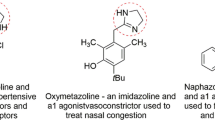Abstract
In this work a dihydrotestosterone–ciprofloxacin conjugate was synthesized. The route involved preparation of a ciprofloxacin–ethylenediamine derivative by the reaction of ciprofloxacin with ethylenediamine using a carbodiimide or boric acid as catalysts. Additionally, the ciprofloxacin derivative was bound to dihydrotestosterone hemisuccinate to form the dihydrotestosterone–ciprofloxacin conjugate in the presence of a carbodiimide. The antibacterial activity of dihydrotestosterone–ciprofloxacin, as well as ciprofloxacin–ethylenediamine and ciprofloxacin, was evaluated in vitro on S. aureus and E. coli using the dilution method and the minimum inhibitory concentration. To delineate the structural chemical requirements of the compounds ciprofloxacin, ciprofloxacin–ethylenediamine and dihydrotestosterone–ciprofloxacin conjugate as antibacterial agents on S. aureus and E. coli, other parameters such as the descriptors logP, π, R m , and V m were calculated. The results showed that bacterial growth of the microorganisms studied was inhibited by ciprofloxacin, ciprofloxacin–ethylenediamine and dihydrotestosterone–ciprofloxacin in a dose-dependent manner. These data suggest that functional groups involved in the structure of the studied compounds are specific for their antibacterial activity.
Graphical abstract







Similar content being viewed by others
References
Pinner RW, Teutsch SM, Simonsen L, Klug LA, Graber JM, Clarke M (1996) J Am Med Assoc 275:189
Crossley KB, Peterson P (1996) Clin Infect Dis 22:209
Norman DC (1996) Clin Geriatr Suppl 1:3
Chambers HF (2001) Emerg Infect Dis 7:178
Podschun R, Ullmann U (1998) Clin Microbiol Rev 11:589
Lautenbach E, Patel JB, Bilker WB, Edelstein PH, Fishman N (2001) Clin Infect Dis 32:1162
Rothstein DM, Hartman A, Cynamon M, Eisenstein B (2003) Expert Opin Investig Drugs 12:255
Wilson WR, Karchmer AW, Dajani A (1995) J Am Med Assoc 274:1706
Yoo B, Triller D, Yong C, Lodise T (2004) Ann Pharmacother 38:1226
Killgore M, March K, Guglielmo B (2004) Ann Pharmacother 38:1148
Hackbarth CJ, Chambers H (1989) Antimicrob Agents Chemother 33:995
Maguire GP, Arthur AD, Boustead PJ, Dwyer B, Currie B (1998) J Hosp Infect 38:273
Peschel A (2002) Trends Microbiol 10:179
Yeaman M, Younth N (2005) Pharmacol Rev 55:27
Gordon E, Barrett R, Dower J (1994) J Med Chem 37:1385
Schwab U, Gilligan P, Jaynes J, Henke D (1999) Antimicrob Agents Chemother 43:1435
Patch JA, Barron A (2003) J Am Chem Soc 125:12092
Barry AL, Jones RN, Thornsberry C, Ayers LW, Gerlach EH, Sommers HM (1984) Antimicrob Agents Chemother 25:633
Chu DT, Fernandez PB, Maleczka RE, Nordeen CW, Pernet AG (1987) J Med Chem 30:504
Tomisic ZB, Kujudzic N, Krajacic MB, Visnjevac A, Kojic-Prodic B (2002) J Mol Struct 611:73
Foroumadi A, Emami S, Mehni M, Moshafi MH, Shafiee A (2005) Bioorg Med Chem Lett 15:436
Foroumadi A, Ghodsi S, Emami S, Najjari S, Samadi N, Faramazi MA, Beikmohammadi L, Shirazi FH, Shafiee A (2006) Bioorg Med Chem Lett 16:3499
Foroumadi A, Emami S, Mansouri S, Javidnia A, Sheid-Adeli N, Shirazi FH, Shafiee A (2007) Eur J Med Chem 42:985
Arayne MS, Sultana N, Haroon U, Mesaik MA, Asif M (2009) Arch Pharm Res 32:967
Chiong R, Betancourt A (1985) Inst Nal Hig, Epidemiol Microbiol, Cuba, pp 24–30
Rannard SP, Davis NJ (2000) Org Lett 2:2117
Bode JW, Sohn S (2007) J Am Chem Soc 129:13798
Hauser RS, Hoffenberg D (1995) J Org Chem 20:1448
Medvedeva A, Andreev M, Safronova L, Sarapulova G (2001) Arkivoc ix:143
Levin D (1997) Org Process Res Dev 1:182
Pingwah T (2005) Organic Synth 81:262
DeSilva NS (2003) Am J Respir Cell Mol Biol 29:757
Figueroa-Valverde L, Díaz-Cedillo F, Tolosa L, Maldonado G, Ceballos-Reyes G (2006) J Mex Chem Soc 50:42
Sirot D, Goldstein F, Soussy C, Courtieu A, Husson M, Lemozy J, Meyran M, Morel M, Perez R, Quentin-Noury C (1992) Antimicrob Agents Chemother 36:1677
Bryan L, Vandenelzen H (1975) J Antibiot 28:696
Barcina I, Arana I, Santorum P, Iriberri J, Egea L (1995) J Microbiol Methods 22:139
Fisher-Kates W (1990) Handbook of lipid research: glycolipids, phospholipids, and sulfoglycolipids. In: Kates M (ed) Plenum Publishing Corp., New York, pp 123–234
Figueroa-Valverde L, Díaz-Cedillo F, López-Ramos M, Díaz-Ku E (2009) Asian J Chem 21:6209
Figueroa-Valverde L, Díaz-Cedillo F, López-Ramos M, Díaz-Ku E (2009) Asian J Chem 21:7173
Ding B, Guan Q, Walsh JP, Boswell JS, Winter TW, Winter ES, Boyd S, Li C, Savage P (2002) J Med Chem 45:663
Ding B, Taotofa U, Orsak T, Chadwell M, Savage P (2004) Org Lett 6:3433
Leo A, Jow PY, Silipo C (1975) J Med Chem 18:865
Leo A, Hoekman D (2000) Perspect Drug Discov Design 18:19
Hansch C, Leo A, Taft RW (1991) Chem Rev 91:165
Mannhold R, Waterbeemd H (2001) J Comput Aided Mol Design 15:337
Hansch CA (1969) Acc Chem Res 2:232
Bryantsev SV, Hay PB (2006) J Phys Chem 110:4678
Erlanger FB, Borek F, Beiser MS, Lieberman S (1957) J Biol Chem 228:713
Acknowledgments
We are grateful to Enriqueta Valverde Anzurez, Glafira Valverde Anzurez, and Gloria Velazquez Zea for technical assistance.
Author information
Authors and Affiliations
Corresponding authors
Rights and permissions
About this article
Cite this article
Figueroa-Valverde, L., Díaz-Cedillo, F., Camacho-Luis, A. et al. Synthesis of a dihydrotestosterone–ciprofloxacin conjugate: relationship between descriptors logP, π, R m , and V m and its antibacterial activity in S. aureus and E. coli . Monatsh Chem 141, 373–380 (2010). https://doi.org/10.1007/s00706-010-0263-y
Received:
Accepted:
Published:
Issue Date:
DOI: https://doi.org/10.1007/s00706-010-0263-y




